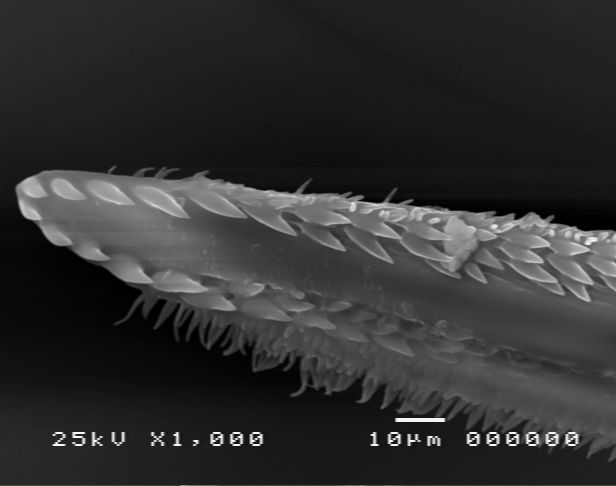Chrysops nigribimbo:
Chrysops sp., commonly referred to as a deer fly, is a vector of human disease in places such as Africa for parasites like Loa loa, the African eye worm. This study sought to describe some of the sensory structures within the labrum and into the foregut of the biting fly focusing primarily on the setiform and basiconic sensilla. The distal portion of the labrum, the vestibule, always contains two basiconic sensilla and two setiform sensilla, followed by the food canal which contains two basiconic sensilla and a variable number of setiform sensilla. The cibarium, proximal to the labrum, consists of the epipharyngeal region containing only setiforms, the median patch containing both types and the stomaedeum which contains two pairs of basicones. SEM was used to investigate and characterize the morphology of the sensilla. All setiform were found to be aporous. Basicones appear to be aporous with differently shaped bodies.

The Mouthparts
Deer flies contain six piercing stylets. These stylets enter the body when the insect feeds. An additional stylet, the labium holds the six stylets when the fly is not feeding. The stylets are the mandibles, the maxillae, the hypopharynx and the labrum. Pictured above is a maxilla used to tear capilleries with aid from the mandibles. The hypopharnyx secretes juices to thin the blood and the labrum pulls the blood up and into the fly.

Habitat
Deer flies often are found around ponds and other areas of large bodies of still water. This is because their larval stages require the environment to become adults. Our deer flies were caught near McClintic State Wildlife Station by visiting Mohammed and Dr. Joy who served as live bait!
A little about Chrysops sp.
Chrysops are members of the family Tabanidae. They have a single set of wings and a body that consists of an head, thorax and abdomen. One can distinguish deer flys from other Tabanids due to their unique antennae that extend well beyond their body and also their painted wings. These wing patterns are unique to each speices and are used in identification.
